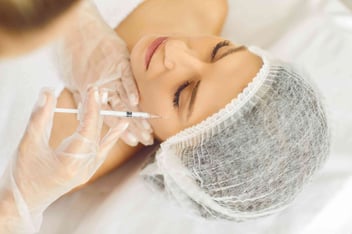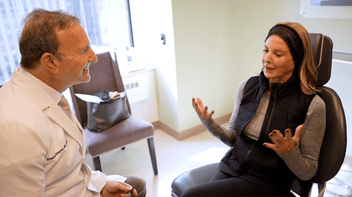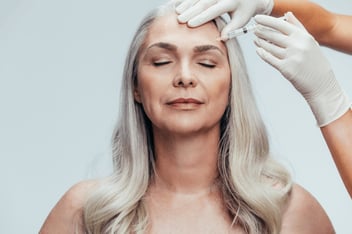
In recent years, the digital age and societal shifts, particularly highlighted during the pandemic, have significantly transformed the aesthetic landscape. This era, marked by our near-constant immersion in social media and virtual interactions, has increased the visibility of aesthetic enhancements and reshaped how we perceive and approach beauty.
With an overload of images and videos showcasing everything from subtle non-surgical tweaks to dramatic surgical transformations on our TikTok and Instagram feeds, individuals are increasingly curious about the possibilities of combining different aesthetic treatments.
This interest often leads to the consultation question: "Can I get a surgical procedure done if I've recently undergone a non-surgical one?"
This evolving dialogue reflects a broader interest in leveraging the full spectrum of aesthetic options available, from minimally invasive treatments like neuromodulators and fillers to more definitive surgical solutions.
The blend of non-surgical and surgical approaches suggests a new paradigm in personal aesthetics, where the choice of treatment extends beyond the 'what' and 'why' to a more careful consideration of 'how' different procedures can be utilized together for optimal results.
What's the difference between non-surgical and surgical procedures?
Non-surgical procedures are commonly non-invasive, avoiding incisions and often leading to faster recovery times. They encompass treatments such as laser skin procedures, dermal fillers, and neurotoxins, providing temporary results that might require maintenance. Surgical procedures, like facelifts or blepharoplasty, involve more extensive changes, including tightening of muscles and removal of excess skin, offering more permanent outcomes.
What to consider: Areas of the Body
When contemplating surgical procedures after undergoing non-surgical treatments, one of the critical considerations is the area of the body where these interventions were or will be performed. The impact on surgical considerations can vary significantly depending on whether the non-surgical and surgical procedures target the same, similar, or entirely different areas of the body.
Same Area Interventions
When non-surgical and surgical procedures are planned for the same area of the body, the prior treatments can have a more direct impact on surgical planning and outcomes. For example, if you've had non-surgical skin tightening or filler injections in the facial area and are considering a facelift, your surgeon will need to take into account the altered tissue characteristics, such as increased collagen production or the presence of filler material, which could affect the ease of making incisions, the approach to reshaping tissues, and the overall healing process.
Similar Area Interventions
Procedures in similar areas may also require special consideration, although the impact might be less direct than with interventions in the same location. For instance, non-surgical fat reduction in the abdomen and a subsequent tummy tuck surgery involves adjacent but not identical tissues and planes. The previous treatments can still influence surgical outcomes by altering the tissue quality and the distribution of fat, affecting the surgical technique and the aesthetic results.
Different Area Interventions
When non-surgical treatments and surgical plans target entirely different areas of the body, the impact on surgical considerations might be minimal regarding direct tissue interaction. However, it's important to consider the body's overall physiological response to previous treatments, such as inflammation or healing processes, which could influence surgical recovery and outcomes.
Regardless of the targeted areas, fully disclosing all previous non-surgical treatments to your surgeon is vital. This transparency allows for tailored surgical planning to navigate any complexities introduced by past procedures.
Factors Influencing the Waiting Period
Deciding on the optimal time to undergo a surgical procedure after receiving non-surgical treatments involves several critical factors. Understanding these can help ensure your body is in the best possible condition for surgery, minimizing risks and optimizing outcomes.
Type of Non-Surgical Procedure
The kind of non-surgical treatment you've undergone plays a significant role in determining the appropriate waiting period before surgery. Treatments like neuromodulators and dermal fillers, which are minimally invasive and have localized effects, typically require shorter waiting times.
For example, the effects of Botox usually last 3-4 months, and many surgeons recommend waiting until these effects have diminished to ensure the surgical assessment and planning are not impacted by the temporary changes these injectables induce.
On the other hand, treatments that involve more extensive tissue manipulation or longer-lasting effects, such as laser skin resurfacing, deep chemical peels, or intense pulsed light therapies, necessitate longer waiting periods. These procedures can induce significant changes in the skin, including increased collagen production and alterations in tissue structure, which need time to stabilize before any surgical intervention.
Tissue Healing
The healing process is a complex and time-dependent aspect of the body's response to any treatment. Regardless of intensity, non-surgical procedures initiate a healing response in the treated tissues. It's crucial to allow this process to be completed to ensure that the surgical site is optimal. Complete healing minimizes the risk of complications such as inflammation, infection, or unsatisfactory aesthetic outcomes.
The skin may appear fully healed within a few weeks after a procedure like microneedling or a moderate chemical peel. Still, the underlying processes, including collagen remodeling, can continue for several months. Surgeons may advise waiting several months post-treatment to ensure these dynamic changes have settled and the skin's structure is stable.
Individual Factors
It's also essential to consider factors such as age, skin type, overall health, and how quickly one's body tends to heal. These personal attributes can significantly influence the waiting period, as each person's healing timeline can vary. Consulting with a board-certified plastic surgeon can provide personalized advice based on your circumstances and treatment history.
Remember: the primary goal of any waiting period is to ensure your safety and the success of your surgical procedure. Patience and adherence to professional guidance are paramount in achieving the best results!
Is it Better to Combine Treatments?
The decision to combine surgical and non-surgical cosmetic treatments can often lead to the most effective and satisfying outcomes. This approach allows for a more nuanced and comprehensive transformation by addressing various aesthetic concerns simultaneously, often with the added benefits of reduced overall downtime and cost.
Advantages of Combining Treatments
Comprehensive Transformation: Many individuals have multiple aesthetic goals that require a blend of approaches for optimal results. Combining treatments can provide a more holistic improvement, enhancing different facial features or body areas to achieve harmony and balance.
Efficiency and Synergy: Addressing several concerns in one comprehensive treatment plan can be more efficient than tackling them separately. This can minimize recovery time and enhance the overall aesthetic outcome, as the improvements in different areas complement each other.
Cost-Effective: While not always the case, combining procedures can sometimes be more cost-effective than undergoing them separately. This is due to shared resources like facility use, anesthesia, and potentially reduced recovery time, which might lower indirect costs such as time off work.
Examples of Combined Treatments
- Botox® and Upper Blepharoplasty: Injecting Botox® between the eyes can smooth deep furrows, while an upper blepharoplasty (eyelid surgery) removes excess skin to rejuvenate and open up the eyes. This combination can significantly refresh the upper face, making it appear more alert and youthful.
- Chin Augmentation and Botox® Jaw Reduction: Placing a silicone implant for chin augmentation can enhance the chin's projection and balance the profile. When combined with Botox® injections to slim the jawline, this approach can sculpt the lower face, creating a more defined and aesthetically pleasing facial contour.
- Facial Fillers and Neck Liposuction: Utilizing dermal fillers for targeted lips enhancement, softening smile lines, and augmenting the cheeks can rejuvenate the lower face and neck area. Adding volume to the cheeks enhances the facial contours, creating more pronounced 'peaks and valleys' that contribute to a more defined jawline and reduce the appearance of a double chin. Complementing these filler applications with neck liposuction further refines the appearance, promoting a more youthful and cohesive look.
- Rhinoplasty and Liquid Facelift: A surgical rhinoplasty can improve the shape of the nose and enhance breathing functionality. When combined with a liquid facelift — using injectables to reduce under-eye bags and restore facial volume — the result can be a more harmonious facial symmetry and rejuvenation.
Impressions Face + Body
At Impressions Face + Body, our commitment to holistic and harmonious beauty transformations is brought to life by a team of distinguished professionals, each bringing a unique blend of expertise, innovation, and compassionate care to our practice.
Dr. Steven Dayan, a luminary in facial plastic surgery, embodies the intersection of surgical excellence, academic contribution, and thought leadership. With a repertoire that includes best-selling publications, prestigious awards, and significant contributions to medical journals, Dr. Dayan's influence extends well beyond the operating room. His role in founding multiple ventures related to aesthetic innovation and education underscores his commitment to advancing the field.
Dr. Benjamin Caughlin is recognized globally for his pioneering work in facial aesthetics, particularly noted for his proprietary techniques like Cheekago™ and The Face BBL™. His unique expertise in internal cheek sculpting and jawline definition sets him apart, making him a sought-after authority in facial rejuvenation. Dr. Caughlin's engaging presence on social media platforms demystifies the complexities of facial plastic surgery, making it accessible and understandable to a broader audience.
Michelle M. Ruffino, MS, PA-C, brings over two decades of clinical experience to our team, with a specialized focus on aesthetics that spans 16 years. Her extensive training background and involvement in clinical research highlight her dedication to advancing practice standards and fostering the next generation of medical professionals.
Selika Gutierrez-Borst, MS, RN, with her deep clinical background and specialized training in aesthetic medicine, exemplifies the blend of technical skill and patient-centred care that defines our practice. Her commitment to education, both within the medical community and among aspiring medical professionals, reflects our collective mission to elevate the standards of aesthetic treatment.
Together, our team at Impressions Face + Body is united by a shared vision: to achieve aesthetic excellence through a blend of cutting-edge techniques, personalized care, and a deep understanding of the individual needs and aspirations of our clients. We believe in the power of combining surgical precision with non-surgical treatments to create results that are not just transformative but deeply resonant with the personal identities of those we serve.
Read On


Facial Rejuvenation During Cancer Treatment
The journey through cancer treatment often involves more than just fighting the disease at a...

The Best Wrinkle Reducers: Neuromodulators
As we age, our faces tell the story of our lives, with laughter lines and thoughtful furrows. These...

